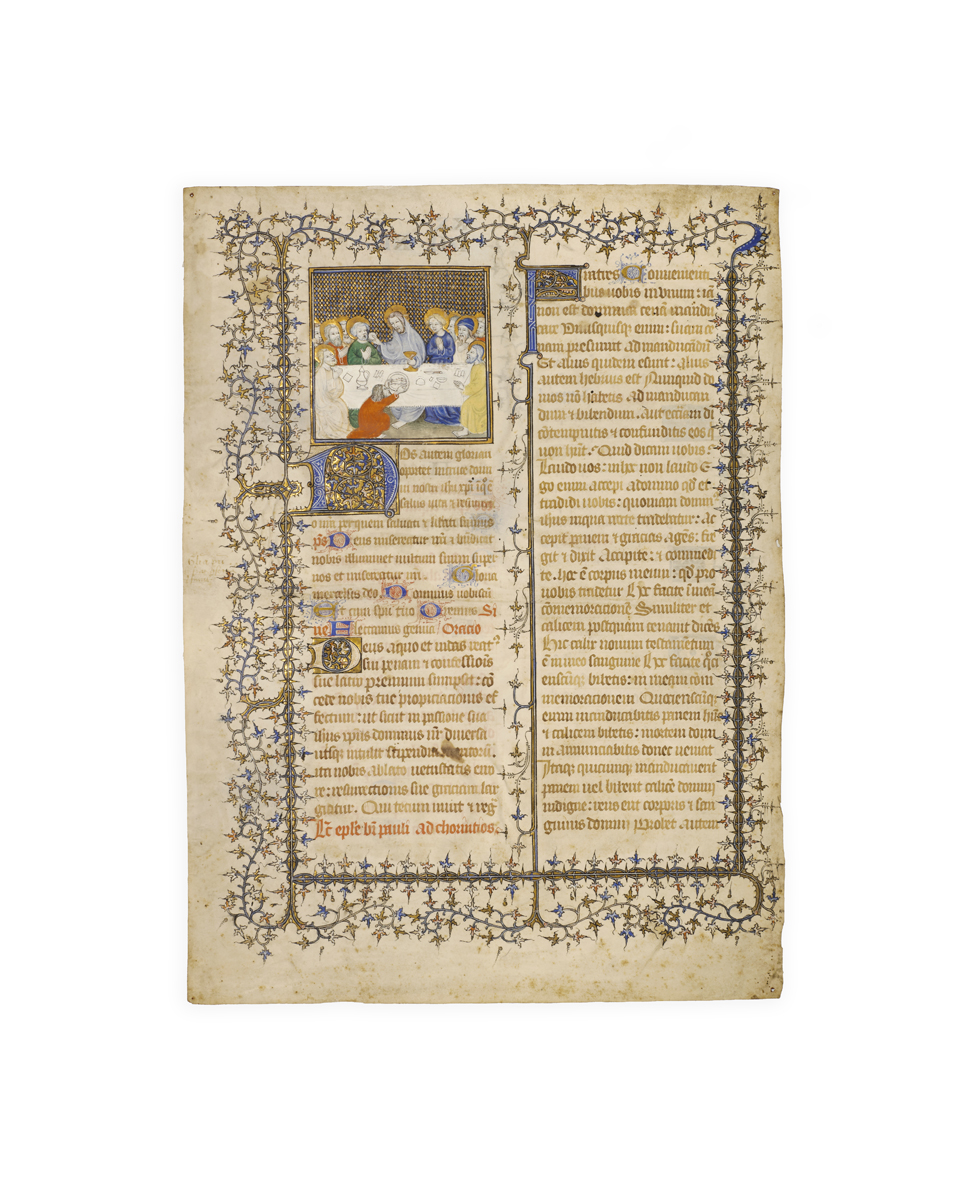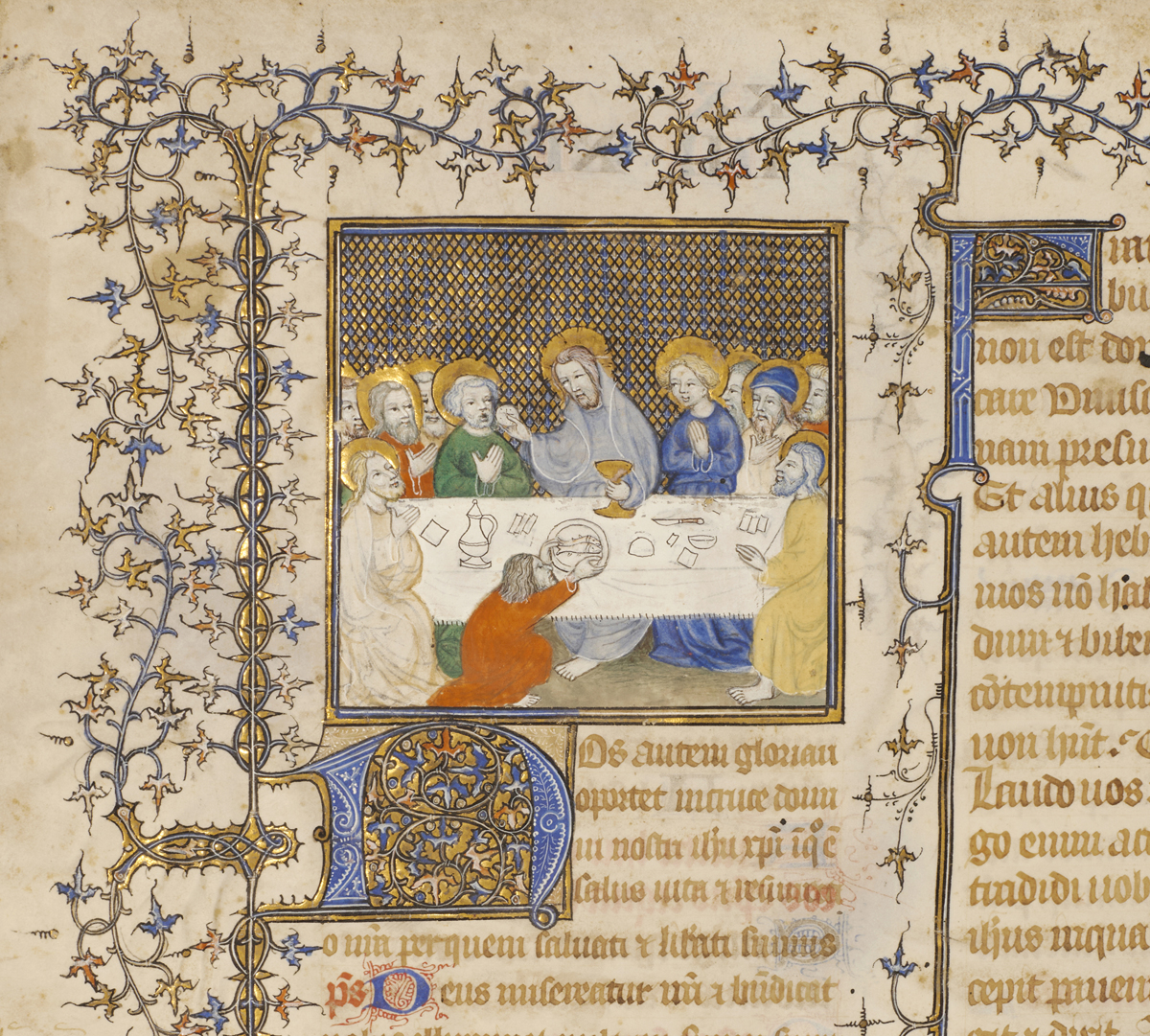

THE MASTER OF DEATH AND THE ‘A MASTER’
PONTIFICAL-MISSAL,
Use of Luçon, in Latin, with readings for the Fourth Week of Lent and Holy Thursday in the Temporal;
France (Paris), late fourteenth century.
a complete leaf with double columns of 32 lines in two sizes of a gothic liturgical script, brown ink, ruled lightly in ink, with a 10-line column-width miniature of the Last Supper (75 x 77 mm) delicately painted in colours and burnished gold and with a tessellated background, large four-line initial ‘N’ (Nos autem gloriari oportet) of leafy design in shades of blue, orange and burnished gold against a quadrangular pink panel, full ivyleaf bar border, six two-line initials alternately in pink and blue usually with ivyleaf border extensions, smaller initials alternately in burnished gold and blue with penwork flourishing in dark blue and red respectively, foliation ‘XX IIII XII’ (i.e. 92) at head of recto in alternating gold and blue letters with similar flourishing, rubrics; some minor rubbing, soiling and cockling, a few tiny losses from miniature and tablecloth area possibly sometime retouched, one or two small stains, old pen trials in lower margin of recto, tiny holes in corners where evidently once pinned to a hard surface, but generally in very good condition. 345 x 256 mm (text area 240 x 171 mm).

Added to your basket:
Use of Luçon, in Latin, with readings for the Fourth Week of Lent and Holy Thursday in the Temporal;
A rediscovered leaf from the Missal of Etienne de Loypeau, bishop of Luçon, with a miniature by the so-called Master of Death and border decoration attributable to the ‘A Master’ of the Belles Heures of the Duc de Berry.
The manuscript from which this refined leaf comes is Bayeux, Bibliothèque du Chapitre MS 61 (now Caen, Archives Départementales du Calvados). The leaf evidently belonged between ff. 91 and 93 and was already missing by 15 November 1893 when a note listing the lacunae was inserted at the beginning of the manuscript. In 1887 nine leaves had been listed as in the Mancel collection in Caen (see Catalogue général des manuscrits des bibliothèques publiques de France, 1889, vol. X pp. 325-6). The Mancel leaves were reinserted in 1893, leaving nineteen leaves still missing. Four leaves, bought by C.L. Ricketts from the Parisian dealer Lemallier in 1907, are now Indiana University, Lilly Library MS Ricketts 65. According to Delisle, writing in 1887, the abbé Deslandes believed that, besides the nine leaves in the Mancel collection, ‘il y en a un ou deux autres dans le cabinet d’un amateur de Bayeux’ (L. Delisle, ‘Le Missel et Pontifical d’’Etienne de Loypeau évêque de Luçon’, in Bibliothèque de l'École des chartes vol. 48, 1887, pp. 527–534 at p. 534).
‘The Missal and Pontifical of Étienne de Loypeau is intimately connected with the cirle of Jean, duc de Berry (1340–1416), brother of Charles V of France and probably the most famous manuscript patron of the late Middle Ages. Before his appointment as bishop of Luçon in central France in 1388, Étienne de Loypeau had been a member of the duc’s household in Poitiers, living in the castle shown in the background of the July miniature of the duc de Berry’s Très Riches Heures, where he was keep of the ducal relics in 1377–82. Étienne’s Missal and Pontifical includes a rubric about the relics of Saint Hilary in Poitiers, citing an indulgence granted by the bishop’s “supreme prince, master and benefactor”, the duc de Berry (fols. 22v–23r). It is not at all improbable that the manuscript was actually commissioned by the duc de Berry himself for presentation to his protégé Étienne de Loypeau, in or soon after 1388. In exchange, then, Étienne ordered a copy of his new manuscript, which he sent back to the duke, who in turn gave it to the Sainte-Chapelle in Bourges. It survives as Paris, BnF, ms lat. 8886 … The hand of the artist of the five Ricketts miniatures appears in many other very grand Parisian manuscripts of the late fourteenth and early fifteenth centuries, including aristocratic texts owned by Charles V and his brothers the dukes of Burgundy and Berry. He was clearly a favourite court artist. The late Michael Camille named him as the ‘Master of Death’ and confidently identified him with Pierre Remiet, an illuminator recorded in Paris between 1368 and c. 1420. This thesis depends on the assumption that Pierre Remiet was the principal painter of a manuscript of the Pèlerinage de la vie humaine, which includes the name of Remiet in the margin, BnF, ms fr. 823, fol. 18v. Probably, in fact, Remiet was no more than the Master’s assistant in that particular manuscript … This does not alter the fact that the unnamed Master of Death was the painter of a substantial number of major royal and noble manuscripts, which increases the likelihood, first hinted at by Delisle 1887, that the duc de Berry himself (rather than a remote bishop) actually commissioned the Missal’ (C. de Hamel, Gilding the Lilly. A hundred medieval and illuminated manuscripts in the Lilly Library, 2010, no. 51, pp. 114-5).
Provenance:
1. Commissioned for Étienne Loypeau, bishop of Luçon from 1388 to 1407.
2. Louis d’Harcourt, patriarch of Jerusalem and bishop of Bayeux from 1460 to 1479, who bequeathed the parent manuscript to the chapter of his cathedral on 12 April 1474. It is recorded in the inventory of the cathedral treasury in 1476: ‘Premièrement, ung excellent missel, portant tout l’office pontifical’ (Delisle, op. cit. p. 534).
References:
Leroquais, Les pontificaux manuscrits des bibliothèques publiques de France, 1937, vol. I pp. 69-75. For the ‘A Master’, see A.S. Farber, ‘Considering a marginal master: the work of an early fifteenth-century, Parisian manuscript decorator’, in Gesta 32, no. 1 (1993), pp. 21-39.